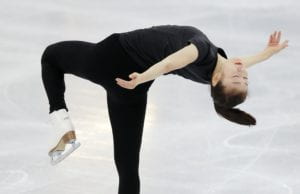Goal 2: Disseminate newly gained knowledge and resources for custom fabricated, pediatric orthoses, by delivering professional presentations and mentoring staff.
AOTA Standards of Continuing Competence: Standard 2. Critical Reasoning and Standard 3. Interpersonal Abilities.

In figure skating, the camel spin is a more advanced position because it requires one leg to be off the ice while still using the arms to balance the upper body. It represents my increasing confidence in pediatric handling skills; and orthosis application. I am opening myself up and ready to share this new knowledge with my colleagues.
I have two artifacts demonstrating my advanced competence in the knowledge and use of atypical orthosis materials. As a program specialist in the Occupational Therapy Department, part of my responsibilities is to complete an annual program evaluation and competency check, focused on fabrication and use of orthoses. Artifact 1 is a powerpoint version of a 60 minute professional presentation, including a 30 minute lab, to NYU Langone Family Health Center OT colleagues/interns in Brooklyn. Following the professional presentation, a 30 minutes lab was used to practice fabricating orthoses using atypical materials of aluminum wire and neoprene. I signed a standard competency form stating that the therapists verbalized understanding of the wear and care of the materials through case discussions and that they demonstrated competency in the correct application of the materials. The therapists kept their orthosis fabrications; as examples, along with starter kits to take back with them to their respective outpatient sites. Artifact 2 describes the contents of these starter kits.
Artifact 1 – Pediatric Orthoses Professional Presentation
Artifact 2- Starter Kits of Atypical Orthosis Materials
Reflections
The feedback I received was very positive. Participants; especially appreciated the case scenarios and my use of atypical materials in specific situations. All of the therapists appreciated receiving the starter kits for their own treatment areas and expressed the desire to have more time using the materials with my supervision. Considering this feedback, I will schedule an hour for the lab portion in the future, instead of 30 minutes.
I followed up with each of the five therapists and I learned that within three months of the presentation, the outpatient therapists were using the provided materials to make aluminum wire orthoses consistently in the clinic. It was fulfilling to learn of the impact this inservice had on their approach to treatment. However, I found that the neoprene materials were not consistently being used, mainly due to the time required to apply the iron-on seam tape. Considering this feedback, I ordered a different material, felt neoprene with double sided velcro strap to use in place of the seam tape. This has made a significant impact in the increased use of the neoprene material.
Initially, the therapists who attended the presentation were surprised at my follow-up of the use of the materials in their respective areas. By soliciting feedback from the staff, making changes and offering solutions, this facilitated my role as a leader and mentor. I realized that the role of a leader involves initiation but also, comes with some risk of being criticized and challenged.
